Passengers 37 Name Continental Flight Crew count 8 Survivors 0 (1 initially) | Fatalities 45 (44 initially) Date May 22, 1962 Role Aircraft accident Passenger count 37 | |
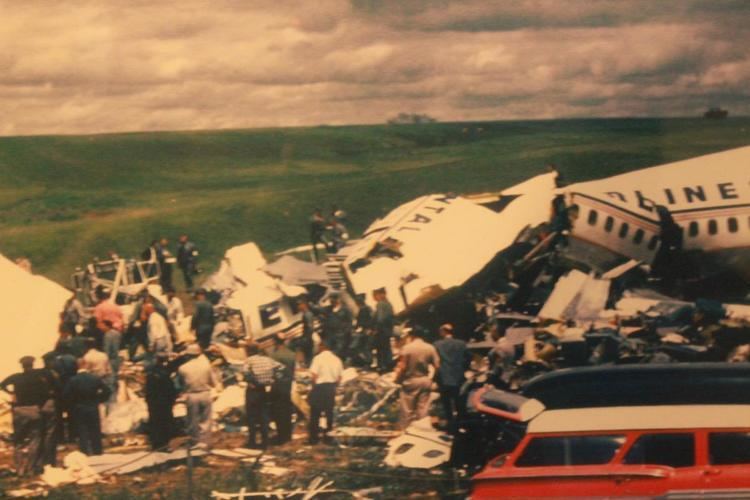 | ||
Site Union Township, Putnam Countynear Unionville, Missouri, United States40°32′49.43″N 93°3′28.25″W / 40.5470639°N 93.0578472°W / 40.5470639; -93.0578472Coordinates: 40°32′49.43″N 93°3′28.25″W / 40.5470639°N 93.0578472°W / 40.5470639; -93.0578472 Similar American Airlines Flight 1, Air India Flight 182, American Airlines Flight 11, Northwest Airlines Flight 253, Pan Am Flight 103 | ||
Injuries (non-fatal) 1 (initially) | ||
Continental airlines flight 11
Continental Airlines Flight 11, registration N70775, was a Boeing 707 aircraft which exploded in the vicinity of Centerville, Iowa, while en route from O'Hare Airport, Chicago, Illinois, to Kansas City, Missouri, on May 22, 1962. The aircraft crashed in a clover field near Unionville, in Putnam County, Missouri, killing all 45 crew and passengers on board. The investigation determined the cause of the crash was a suicide bombing committed as insurance fraud. The plane had been hijacked to Cuba the previous year as Flight 54.
Contents
- Continental airlines flight 11
- Remebering the victims of continental airlines flight 11
- Aircraft history
- Crash
- Investigation
- References
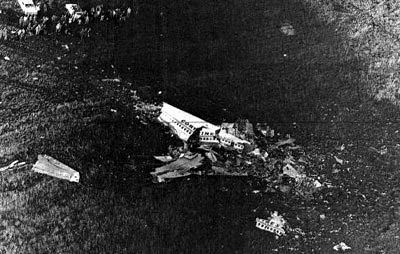
Remebering the victims of continental airlines flight 11
Aircraft history
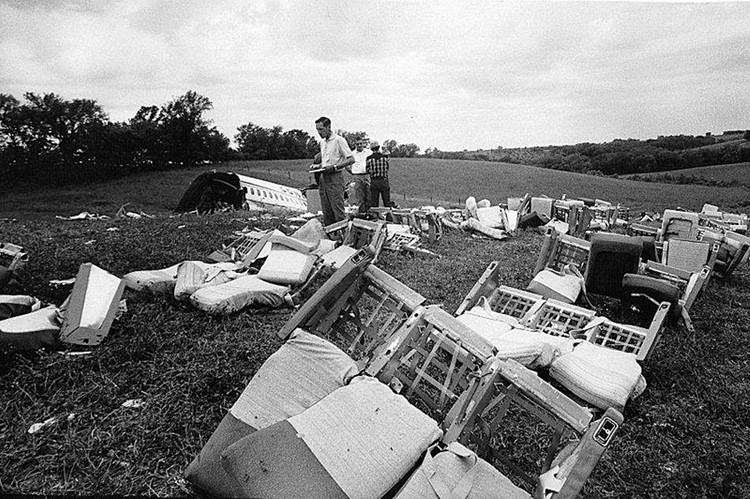
The aircraft, as Continental Airlines Flight 54, was hijacked from Los Angeles by two men, Leon and Carl Bearden, demanding to be flown to Cuba on August 3, 1961. The hijacking was thwarted when police shot out the tires.
Crash

Thomas G. Doty arrived at the gate after the doors had been closed. Although airline policy is that once the doors are closed they are not to be reopened, the doors were reopened and Doty was allowed to board.
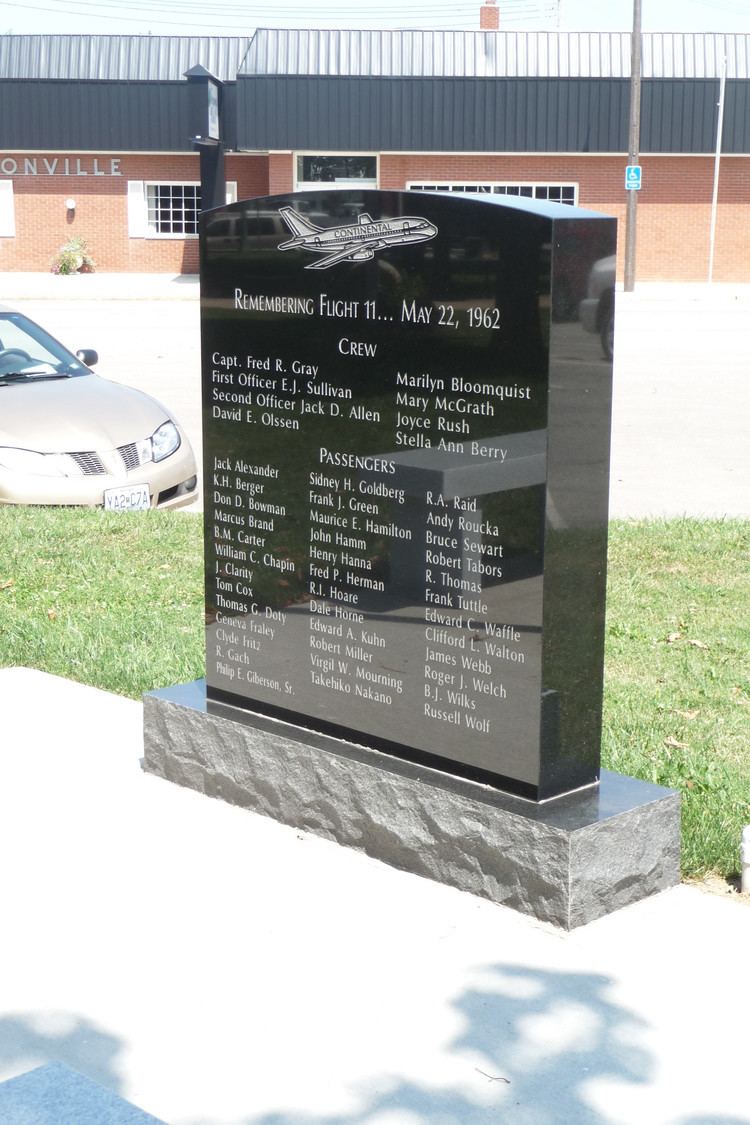
Flight 11 departed O'Hare at 8:35 p.m. The flight was routine until just before the Mississippi River, when it deviated from its filed flight plan to the north to avoid a line of thunderstorms. In the vicinity of Centerville, Iowa, the radar image of the aircraft disappeared from the scope of the Waverly, Iowa, Flight Following Service. At approximately 9:17 p.m. an explosion occurred in the right rear lavatory, resulting in separation of the tail section from the fuselage. The flight crew initiated the required emergency descent procedures and donned their smoke masks due to the dense fog which formed in the cabin immediately after the decompression. At separation of the tail, the remaining aircraft structure pitched nose down violently, causing the engines to tear off, after which it fell in uncontrolled gyrations. The fuselage of the Boeing 707, minus the aft 38 feet, and with part of the left and most of the right wing intact, struck the ground, headed westerly down a 10-degree slope of an alfalfa field.
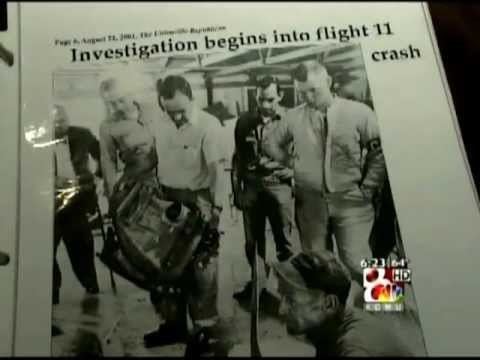
Witnesses in and around both Cincinnati, Iowa and Unionville reported hearing loud and unusual noises at around 9:20 p.m., and two more saw a big flash or ball of fire in the sky. A B-47 Stratojet bomber flying out of Forbes Air Force Base in Topeka, Kansas, was flying at the altitude of 26,500 feet in the vicinity of Kirksville, Missouri. The aircraft commander saw a bright flash in the sky forward of and above his aircraft's position. After referring to his navigation logs he estimated the flash to have occurred at 9:22 p.m. near the location where the last radar target of Flight 11 had been seen. Most of the fuselage was found near Unionville, but the engines and parts of the tail section and left wing were found up to six miles away from the main wreckage.
Of the 45 individuals on board, 44 were dead when rescuers reached the crash site. One passenger, 27-year-old Takehiko Nakano of Evanston, Illinois, was alive when rescuers found him in the wreckage, but he died of internal injuries at Saint Joseph Mercy Hospital in Centerville, Iowa, an hour and a half after being rescued.
Investigation
FBI agents discovered that Doty, a married man with a five-year-old daughter, had purchased a life insurance policy from Mutual of Omaha for $150,000, the maximum available; his death would also bring in another $150,000 in additional insurance (some purchased at the airport) and death benefits. Doty had recently been arrested for armed robbery and was to soon face a preliminary hearing in the matter. Investigators determined that Doty had purchased six sticks of dynamite for 29 cents each, shortly before the crash, and were able to deduce that a bomb had been placed in the used towel bin of the right rear lavatory. Doty went into the lavatory with his briefcase and blew himself up, killing himself and everyone on board. His motive was so that his wife and daughter would be able to collect on the $300,000 of life insurance. His widow attempted to collect on the insurance, but when Doty's death was ruled a suicide, the policy was voided and the widow was only able to get a three dollar refund.
In July 2010, a memorial was erected near the crash site in Unionville, Missouri on the anniversary of the crash.
In May 2012 a special 50th anniversary memorial service was held in Unionville.
